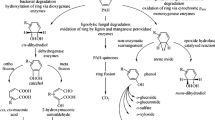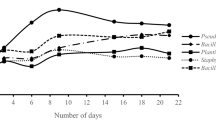Abstract
In the present work, several samples from lab waste containers polluted with polycyclic aromatic hydrocarbons (PAHs) and heavy metals were investigated as potential sources of PAH-degrading microorganisms. After isolating, two fungal strains were selected as the best degrading microorganisms. Genetic identification by sequencing was carried out and they were identified as Trichoderma longibrachiatum and Byssochlamys spectabilis. Their degradation ability was determined in liquid cultures with 100 μM of benzo[a]anthracene. T. longibrachiatum cultures showed highest degradation values (around 97%) after 9 days, furthermore in a second batch the time was reduced to 6 days. To analyse the viability of industrial application, a continuous treatment in an expanded-bed bioreactor was developed operating at different residence times with T. longibrachiatum immobilised on cubes of nylon sponge. It is noticeable that the bioreactor working in continuous mode was able to operate without operational problems and attaining high degradation levels depending on the residence time.



Similar content being viewed by others
References
Pazos M, Rosales E, Alcántara T, Gómez J, Sanromán MA (2010) Decontamination of soils containing PAHs by electroremediation: a review. J Hazard Mater 177:1–11
Badawy MI, Emababy MA (2010) Distribution of polycyclic aromatic hydrocarbons in drinking water in Egypt. Desalination 251:34–40
Napier F, D’Arcy B, Jefferies C (2008) A review of vehicle related metals and polycyclic aromatic hydrocarbons in the UK environment. Desalination 226:143–150
Ling J, Zhang G, Sun H, Fan Y, Ju J, Zhang C (2011) Isolation and characterization of a novel pyrene-degrading Bacillus vallismortis strain JY3A. Sci Total Environ 409:1994–2000
Seo J-, Keum Y-, Li QX (2009) Bacterial degradation of aromatic compounds 6:278–309
Romero MC, Salvioli ML, Cazau MC, Arambarri AM (2002) Pyrene degradation by yeasts and filamentous fungi. Environ Pollut 117:159–163
Zhao H-P, Wu Q-S, Wang L, Zhao X-T, Gao H-W (2009) Degradation of phenanthrene by bacterial strain isolated from soil in oil refinery fields in Shanghai China. J Hazard Mater 164:863–869
Hanson KG, Desai JD, Desai AJ (1993) A rapid and simple screening technique for potential crude oil degrading microorganisms. Biotechnol Tech 7:745–748
Carvalho MB, Martins I, Leitão MC, Garcia H, Rodrigues C, San Romão V, McLellan I, Hursthouse A, Silva Pereira C (2009) Screening pentachlorophenol degradation ability by environmental fungal strains belonging to the phyla Ascomycota and Zygomycota. J Ind Microbiol Biotechnol 36:1249–1256
Feltrer R, Álvarez-Rodríguez ML, Barreiro C, Godio RP, Coque J-R (2010) Characterization of a novel 2,4,6-trichlorophenol-inducible gene encoding chlorophenol O-methyltransferase from Trichoderma longibrachiatum responsible for the formation of chloroanisoles and detoxification of chlorophenols. Fungal Genet Biol 47:458–467
Mann J, Markham JL, Peiris P, Nair N, Spooner-Hart RN, Holford P (2010) Screening and selection of fungi for bioremediation of olive mill wastewater. World J Microbiol Biotechnol 26:567–571
Scelza R, Rao MA, Gianfreda L (2008) Response of an agricultural soil to pentachlorophenol (PCP) contamination and the addition of compost or dissolved organic matter. Soil Biol Biochem 40:2162–2169
Furukawa H, Wieser M, Morita H, Sugio T, Nagasawa T (1999) Purification and characterization of vanillyl-alcohol oxidase from Byssochlamys fulva V107. J Biosci Bioeng 87:285–290
Deive FJ, Domínguez A, Barrio T, Moscoso F, Morán P, Longo MA, Sanromán MA (2010) Decolorization of dye Reactive Black 5 by newly isolated thermophilic microorganisms from geothermal sites in Galicia (Spain). J Hazard Mater 182:735–742
Gargouri B, Karray F, Mhiri N, Aloui F, Sayadi S (2011) Application of a continuously stirred tank bioreactor (CSTR) for bioremediation of hydrocarbon-rich industrial wastewater effluents. J Hazard Mater 189:427–434
Acknowledgments
This work was supported by the Xunta de Galicia (Project 08MDS034314PR). The authors are grateful to Spanish Ministry of Science and Innovation for financial support of Marta Pazos under the Ramón y Cajal programme.
Author information
Authors and Affiliations
Corresponding author
Rights and permissions
About this article
Cite this article
Rosales, E., Pérez-Paz, A., Vázquez, X. et al. Isolation of novel benzo[a]anthracene-degrading microorganisms and continuous bioremediation in an expanded-bed bioreactor. Bioprocess Biosyst Eng 35, 851–855 (2012). https://doi.org/10.1007/s00449-011-0669-x
Received:
Accepted:
Published:
Issue Date:
DOI: https://doi.org/10.1007/s00449-011-0669-x




